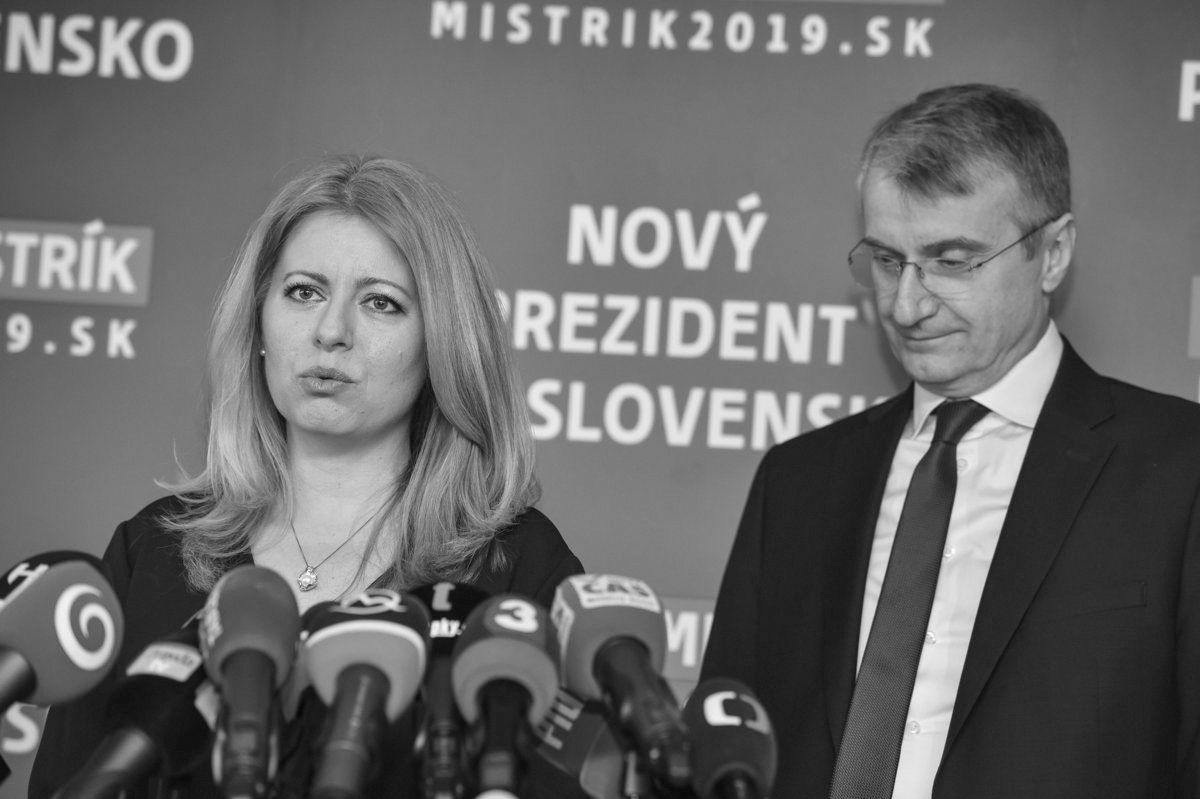By Andrej Matišák | Bratislava
For a relatively small country, as Slovakia is usually described, February 2019 was a month of massive diplomatic importance. On this very rare occasion, several top-level politicians visited over a span of few weeks.
First, it was German Chancellor Angela Merkel’s turn. Slovakia was able to attract her not just for a bilateral visit but also for a meeting of the Visegrád Group during Slovakia’s one-year (July 2018-June 2019) presidency of the V4. Interestingly, Slovakia was successfulin organising a visit by Merkel while Hungary failed to achieve this aim – and, according to various diplomatic sources and experts,not for a lack of trying.
“Berlin clearly acknowledges that, while the V4 positioned themselves strongly as a group during the refugee crisis, the four countries clearly differ among themselves on many other accounts,” said Jörg Forbrig, Senior Transatlantic Fellow for Central and Eastern Europe of the German Marshall Fund. Senior Policy Fellow of European Council on Foreign Relations (ECFR) Josef Janning echoes this. “Berlin is acutely aware of the differences which exist among the four countries, notably some unease in Prague and Bratislava about the very vocal positions of the Polish and Hungarian government vis-a-vis Brussels.”
Second, US Secretary of State Mike Pompeo visited Bratislava in February. And while you can sense a profound scepticism among diplomats and experts directed at President Donald Trump’s administration, Slovakia has tried to position itself as a country that values its trans-Atlantic link very much, but whose interests are intimately connected to the success of the European Union project.
This is a quite a bold strategy, taking into account that the EU is not the most popular subject in the White House.
The third high-profile event that took place in Slovakia in February can be described more like the cherry on top. The format and meaning of the Bucharest Nine is still somehow under construction, but at the end of February Slovak President Andrej Kiska had an opportunity in Košice to welcome not just his eight colleagues from Central and Eastern Europe, but also NATO’s Secretary General Jens Stoltenberg.
However, according to Artur Gruszczak, Associate Professor of Political Science at the Jagiellonian University in Krakow, there are also some divergent views inside the Bucharest Nine. “The group has reflected a regionalist approach to security advocated by its founding members, Poland and Romania. Both are staunch U.S. allies and both have been recently at odds with the EU’s principles and laws,” Gruszczak explains. “The group is a conglomerate of Central and East European countries which share a strategic location, membership in NATO and the EU, as well as a Communist past. They pretend to speak with one voice in key security matters
in the region despite their divergent views on specific issues of security, regional stability and cooperation.”
All politics is local
In the end, all politics is local. And there are divergent views on specific issues even among friends, partners and allies. Slovakia is going through some turbulent times. Since the murder of the journalist Jan Kuciak and his fiancée Martina Kušnírová in February 2018, we have witnessed a revival of the debate over where Slovakia belongs.
Is it a loosely knitted camp of ‘illiberals’ that is gravitating towards the ideas of Hungarian PM Viktor Orbán? Or is it in the more pro- Western, pro-EU camp? Of course, to divide all political decisions into two categories is hugely simplistic. These two camps have various subgroups, and Slovakia in particular is very well known for its pragmatic approaches which have many times been based on the country’s special place in the Visegrád Four, as Slovakia belongs to the Eurozone and the others do not.
But do pragmatic policies still work for Slovakia? Foreign Minister Miroslav Lajčák openly admits that the foreign policy consensus is falling apart. It is good that he is not trying to hide this. On the other hand, it seems that he is only saying something that has been quite evident for a long time. Not to mention that Lajčák is the foreign minister in the third government in which Smer-Sociálna demokracia (Direction–Social Democracy) has had the dominant position. One way or another, he himself has been part of the process of losing the foreign policy consensus.
The foreign policy consensus is falling apart in Slovakia.
And following pragmatic policies is also clearly not enough for the voters. Again, all politics is local. It seems that 26 years after creating an independent state and 15 years after joining NATO and the EU, Slovaks would like to see a new vision for the country. Slovak voters have hardly been specific in explaining what kind of change they want, but the burning desire is there – and they are fed up with the seemingly never-ending stream of cases of (alleged) corruption and misuse of public money.
There is no doubt that this desire has also been influenced by the above-mentioned murders of Jan Kuciak and Martina Kušnírová. Under the banner of ‘For A Decent Slovakia’ it led to the biggest protests since the fall of the Communist regime in 1989. But it also led to widespread conspiracy theories trying to ‘explain’ the horrible crime. These attempts are not confined to dark, disinformation sites online. Now the former PM Robert Fico is their promoter-in-chief.
He has started to blame the philanthropist George Soros, a billionaire of Hungarian origin, for supporting the demonstrations, as after the murder it quickly became clear that the protesters wanted to see Fico’s resignation.
One year after the murder, Slovakia is in full election mode. Voters went to polls in November last year for the regional elections, and in March, Slovaks voted in presidential elections. May is the date of the European Parliament elections, and parliamentary elections should take place in spring next year, though voices claiming that the vote might be held earlier are intensifying.
Slovakia has tried to position itself as a country that values its trans-Atlantic link very much, but whose interests are inti- mately connected to the success of the European Union project.
It also means that the political fight is intensifying, and this could create some surprising outcomes. At the time of writing this article, it was unclear who would become the new President of Slovakia. The incumbent Andrej Kiska had decided not to run again, which left the field open for other candidates. Smer led by the ex-PM Fico, who is still chairman of the party, had desperately been trying to findits own candidate. They failed to convince FM Lajčák, so it was up to Maroš Šefčovič, the European Commission’s Vice-President for the Energy Union, to enter the frame. He was running as an independent, or so he liked to claim, but he had the clear and vocal support of Smer. This seemingly independent candidacy allowed Šefčovic to somehow distance himself from Smer, but on the other hand he was able to use Smer’s resources.
But Smer is probably yesterday’s news. Fico’s party is still the most popular, polling at around 20 percent, but Šefčovič only received 18.66 percent of votes in the first round of the presidential elections. And until the very last moment some political commentators were speculating that Šefčovič could be beaten into second place by Štefan Harabin, a judge on the Supreme Court and ex- justice minister in Fico’s first government, and a radical populist who openly despises NATO and the EU.
In the end Harabin received 14.34 percent of the votes – not a bad result, taking into account the fact that the neo-Nazi candidate Marian Kotleba finished fourth with 10.39 percent, and there is a clear crossover between Harabin’s and Kotleba’s voters. “There is a mood for a big change in the air. But the problem is that different people see this change differently. The political and public elites believe that when we talk about a paradigmatic change, we talk about decent Slovakia and liberal democracy.
It might not work that way. Harabin and Kotleba represent an increasing power,” prominent Slovak sociologist Michal Vašečka said for the daily Denník N, explaining the success of the radical candidates.
Enter Zuzana Čaputová
The 45-year old lawyer is a different face of this paradigmatic change. “Firstly, people are desperate and tired of the emptiness of current Slovak politics; secondly, by bad governance and overwhelming corruption; and most importantly, by the ugliness of public life, which is full of aggressiveness, rough interactions, and an almost psychopathic
brutality. In such a world, Zuzana Čaputová almost seems like a divine revelation to many people,” Vašečka told the Slovak Spectator newspaper.
Čaputová won both rounds of the presidential election with a commanding lead: 40.57 and respectively 58.4 percent. As an activist and judge she has focused on the promotion of the rule of law in cases of environmental protection and corruption in public life. While relatively well known in some circles, she entered politics only in 2018, as a real novice, when she became deputy chairman of the newly-established liberal, pro-EU and pro-NATO party Progressive Slovakia.
Does Čaputová’s victory mean that Slovaks are massively revolting against the tide of populism, against the anti-EU, anti-NATO, anti-migrant, anti-Soros and pro-Putin narratives? Partly. There is no doubt that Čaputová’s core voters are pro- Western orientated urban liberals. But it seems Čaputová’s success could be better explained by the call for a change that is much more universal.
Čaputová can set the tone of the political debate, but she cannot profoundly change the political scene, not to mention the country as a whole. Only a government with a working parliamentary majority can do this.
She was able to attract the biggest share of the youngest voters. No comparison is perfect, but only three years ago this age group clearly supported the neo-Nazi Kotleba in the parliamentary elections. That probably does not mean that Slovak young voters are suddenly rejecting populism and entering the ranks of the European Solidarity Corps. It perhaps says more about Čaputová’s abilities to communicate with them, and that after years of Smer governments and a struggling opposition, which was unable to use the opportunity it received in 2010, people want to see something different. Remarkably, at least according to polls, there are even significant numbers of Harabin’s and Kotleba’s voters who are willing to support Čaputová.
What does this mean for Slovak politics? Frankly, it is hard to say. Čaputová can set the tone of the political debate, but she cannot profoundly change the political scene, not to mention the country as a whole. Only a government with a working parliamentary majority can do this. The viable prospects for the upcoming parliamentary elections are pretty unclear. There is a good chance that Smer will end up winning the elections, albeit with a clearly reduced number of MPs. Still it could be enough, and they could try to form the new government. Or will the fragmented opposition get its turn? They might be able to work together, but as things look now, it would require the cooperation of between four to seven parties, ranging from pro-EU liberals to moderate Eurosceptics and populists.
Asking for a change but getting more of the same, either in the form of a Smer-led government or an incoherent government of opposition parties similar to 2010-2012? Yes, it might easily happen. Many Slovak voters accept this, albeit grudgingly. But some surely do not. How big could this group be, and how will it channel its anger? That is anybody’s guess. But it would be foolish not to pay attention to them, as Čaputová is really only one face of this change.
__
ANDREJ MATIŠÁK is Deputy Chief of Foreign Desk at Pravda daily, Slovakia.


